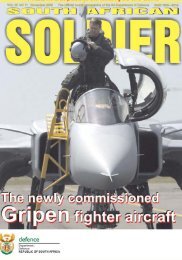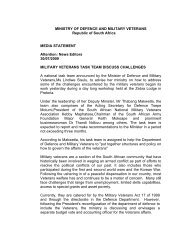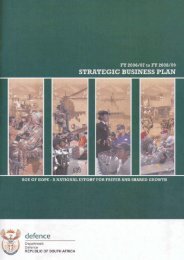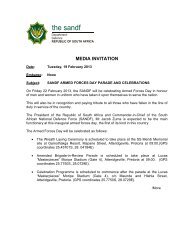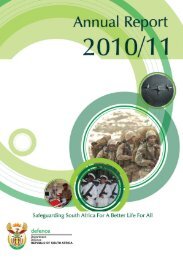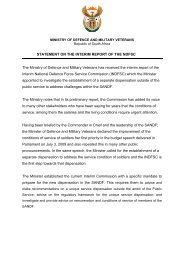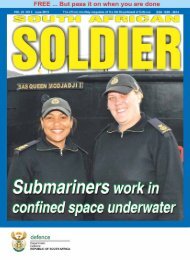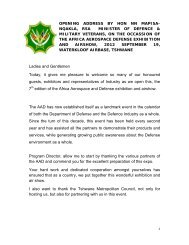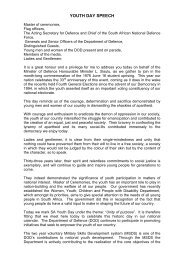Chapter 2 - P rogramme 1 - Department of Defence
Chapter 2 - P rogramme 1 - Department of Defence
Chapter 2 - P rogramme 1 - Department of Defence
Create successful ePaper yourself
Turn your PDF publications into a flip-book with our unique Google optimized e-Paper software.
| <strong>Chapter</strong> 6 - P<strong>rogramme</strong> 4: Maritime <strong>Defence</strong> |<br />
With regard to peace missions, the SA Navy provided<br />
forces in support <strong>of</strong> peace initiatives in Africa. Six<br />
members were deployed in Sudan. Staff <strong>of</strong>ficers and<br />
military observers were deployed in the UN mission<br />
in the Democratic Republic <strong>of</strong> the Congo. A<br />
Maritime Reaction Squadron platoon was deployed<br />
as a protection unit in Burundi. Training assistance<br />
was provided as part <strong>of</strong> the South African Military<br />
Assistance Training Team (SAMATT) initiative to<br />
the Central African Republic.<br />
In terms <strong>of</strong> supporting other Government<br />
departments, preparatory exercises in support <strong>of</strong> the<br />
Soccer World Cup 2010 were conducted. Support<br />
was also provided during the team draw occasion<br />
in Durban. The SA Navy further participated in<br />
joint exercises to monitor the movement <strong>of</strong> air<br />
traffic, in preparation for the Soccer World Cup.<br />
Naval deployments in cooperation with the SAPS<br />
and in support <strong>of</strong> marine and coastal management<br />
in the Western and Southern Cape assisted in the<br />
enforcement <strong>of</strong> State authority and the protection<br />
<strong>of</strong> marine resources such as endangered shellfish.<br />
At the request <strong>of</strong> the Intergovernmental<br />
Oceanographic Commission – UNESCO, real-time<br />
tide-information satellite transmitters were installed<br />
by the SA Navy at the Durban, Port Elizabeth<br />
and Simon’s Town naval bases. These transmitters<br />
contribute to international maritime safety, as they<br />
form part <strong>of</strong> the Indian Ocean Tsunami Warning<br />
System, with the data being used to monitor weather<br />
and tidal patterns.<br />
The Maritime Log Support Plan (MLSP) has<br />
achieved notable successes in its support <strong>of</strong> the<br />
SA Navy’s maritime assets. The recently established<br />
System Support Centre has made a positive difference<br />
in the ability <strong>of</strong> the fleet to maintain its assets and<br />
infrastructure. The SA Navy became the first Service<br />
to have a depot’s accounting system successfully<br />
transferred from DIMS to OSIS. The MSLP has<br />
played a major role in the successful deployment <strong>of</strong><br />
the frigates SAS Amatola to the United Kingdom<br />
and SAS Mendi to Brazil and Ghana. In the weapons<br />
support domain, the first locally designed and<br />
manufactured submarine berthing pontoon was put<br />
into operation, as was a fuel capture tap. With the<br />
implementation <strong>of</strong> the Strategy for the Management<br />
<strong>of</strong> Criminality in the DOD, the SA Navy created a<br />
positive contribution towards managing crime by<br />
adopting a zero-tolerance approach to <strong>of</strong>fenders.<br />
The SA Navy has continued with the pragmatic<br />
implementation <strong>of</strong> the HR 2010 Strategy towards<br />
ensuring that the SA Navy achieves a workforce<br />
Annual Report FY 2007 - 2008 136<br />
| <strong>Department</strong> <strong>of</strong> <strong>Defence</strong> |<br />
that is representative in terms <strong>of</strong> gender and race,<br />
including the accreditation <strong>of</strong> training units. The<br />
SA Navy has initiated special recruitment and<br />
marketing drives in order to identify candidates for<br />
appointment in the Combat, Technical and Diver<br />
branches <strong>of</strong> the SA Navy. In this regard, all provinces<br />
were visited and 633 candidates were successfully<br />
recruited as MSDS members who could in future<br />
be appointed in the Combat, Technical, Diving and<br />
Submarine branches. A further 92 candidates who<br />
are partially technically qualified were recommended<br />
for employment in the MSDS and Core Service<br />
System.<br />
The Military Skills Development p<strong>rogramme</strong><br />
enabled the rejuvenation <strong>of</strong> both Regular and<br />
Reserve components with young, fit and able sailors.<br />
Approximately 42 000 Reserve man-days were<br />
utilised to satisfy force preparation and force support<br />
requirements. The Reserve Management Centre has<br />
proved highly efficient in coordinating the call-up<br />
and utilisation <strong>of</strong> Reserve personnel. Representivity<br />
in terms <strong>of</strong> race and gender is progressing well,<br />
and a well-developed plan to manage people with<br />
disabilities is in place.<br />
The loss <strong>of</strong> personnel within the combat and<br />
technical domains to the private sector remains an<br />
area <strong>of</strong> great concern. However, various initiatives<br />
are being pursued to turn this situation around. The<br />
intervention <strong>of</strong> targeting members with technical<br />
qualifications or partial technical qualifications<br />
to further their training and attain accredited<br />
qualifications has had a positive effect, with such<br />
members being staffed in technical posts.<br />
Despite the constraints that continue to challenge the<br />
SA Navy’s ability to comply with its constitutional<br />
mandate, it achieved its performance objectives<br />
in accordance with the DOD Strategic Business<br />
Plan for FY 2007/08. This bears testimony to the<br />
commitment <strong>of</strong> the men and women who serve in<br />
the organisation. The robust managerial intervention<br />
with clear strategic direction by top leadership<br />
has allowed the SA Navy to remain committed<br />
to pursuing its primary objective <strong>of</strong> providing a<br />
credible maritime defence capability to the people<br />
<strong>of</strong> South Africa.<br />
Purpose<br />
The purpose <strong>of</strong> the Maritime <strong>Defence</strong> P<strong>rogramme</strong><br />
is to provide prepared and supported maritime<br />
defence capabilities for the defence and protection<br />
<strong>of</strong> the Republic <strong>of</strong> South Africa.




